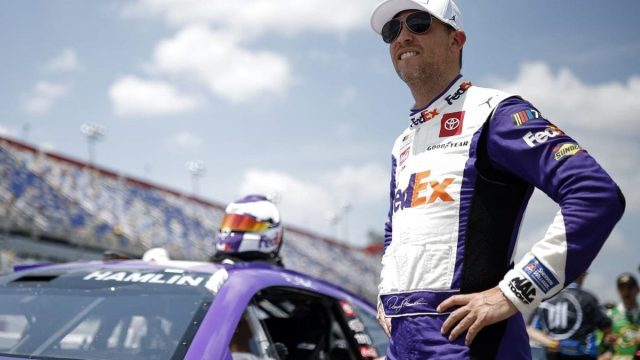Former NASCAR Mechanic Exposes Hamlin’s Expensive Mistake: In a recent exposé, former NASCAR mechanic Dave Green has highlighted a significant error by Denny Hamlin at Joe Gibbs Racing (JGR) that has wide-reaching implications for the team’s fuel management strategy. Green’s analysis explores the intricacies of fuel efficiency and horsepower, critiquing Hamlin’s approach and emphasizing the crucial role of planning in NASCAR. This discovery questions the effectiveness of JGR’s current methodologies and reveals how even small miscalculations can change race dynamics and performance.
Key Highlights
- Hamlin’s comments on Toyota’s higher power and fuel consumption exposed potential regulatory scrutiny.
- Dave Green criticized Hamlin for publicly discussing technical advantages and fuel efficiency.
- Hamlin’s remarks highlighted the crucial balance between vehicle power and fuel efficiency in NASCAR.
- Mismanagement of fuel strategy could lead to significant race repercussions, as seen in Logano’s victory.
- Efficient fuel management, as demonstrated by Logano, is essential to avoid extra pit stops and secure wins.
Joey Logano’s Victory at the Ally 400 in Nashville
In a display of strategic skill and driving talent, Joey Logano secured his initial regular-season win of the year at the Ally 400 in Nashville, overcoming a 26th-place start to succeed at the Nashville Superspeedway. Logano’s performance was a masterclass in tactical racing, leveraging best restart strategies to ascend through the pack. The Team Penske driver demonstrated not only his adeptness behind the wheel but also the vital role of team strategy in securing a victory from a disadvantaged starting position.
Logano’s victory was notably facilitated by the misfortunes of several key competitors. Kyle Larson, Chase Briscoe, and Chase Elliott all encountered fuel-related setbacks, which significantly impaired their race outcomes. These incidents highlight the important balance between speed and fuel management, a balance that Logano and his team navigated with precision. The No. 22 Ford’s ability to maintain fuel efficiency while sustaining competitive speeds highlights the multi-faceted nature of racing success.
The race at Nashville Superspeedway was not merely a test of speed but a complex interplay of strategy, endurance, and adaptability. Logano’s ability to capitalize on restarts, a crucial aspect of NASCAR racing, was symbolic of his seasoned experience and acute racecraft.
Denny Hamlin’s Perspective on Horsepower and Fuel Efficiency
Following Joey Logano’s impressive victory at the Ally 400, Denny Hamlin offered an insightful analysis on the performance differences between Toyota and Ford vehicles, particularly highlighting the impact of horsepower on fuel efficiency. As a seasoned driver for Joe Gibbs Racing, Hamlin’s observations were rooted in practical experience and technical knowledge, making his comments particularly compelling for those interested in understanding the intricacies of NASCAR performance metrics.
Hamlin posited that Toyota vehicles, including his own, typically possess higher power compared to their Ford counterparts. This assertion, while seemingly beneficial in the context of speed and acceleration, comes with a crucial trade-off: fuel consumption. Higher-powered engines, by their very nature, require more fuel, which can lead to more frequent pit stops for refueling throughout a race.
“Look at the cars that ran out first, it was Chevys, then it was Toyotas, then the Fords were last to run out. So when you have more horsepower you typically run out of gas quicker because you use more and more fuel.” – Hamlin
In contrast, Logano’s Ford vehicle exhibited superior fuel efficiency during the Ally 400. Hamlin suggested that this efficiency allowed Logano to extend his fuel mileage further, ultimately finishing the race without the need for an extra pit stop. This strategic advantage emphasizes the delicate equilibrium between power and fuel efficiency, a balance that can significantly impact race results.
Denny openly admits the Toyotas have more horsepower then the Fords which caused Joey to have more fuel. No way Dale Sr in his prime would ever say the Chevys had more horsepower in fear that NASCAR would give the Fords and advantage. This could be a huge mistake for Denny and…
— Dave Green (@nascarprophecy) July 2, 2024
Hamlin’s analysis shows the inherent engineering compromises and provides a valuable lesson in race strategy. The ability to manage fuel consumption without compromising speed is a crucial aspect of NASCAR success. As teams and drivers continually strive to optimize their vehicles, understanding the interaction between power and fuel efficiency remains essential.
Criticism from NASCAR Mechanic Dave Green
Veteran NASCAR mechanic Dave Green has voiced significant concerns regarding Denny Hamlin’s recent assertions about Toyota’s horsepower superiority over Ford vehicles. Green, a two-time NASCAR Craftsman Mechanic of the Year, articulated that such public declarations could have unintended, detrimental consequences for Toyota and Joe Gibbs Racing (JGR).
“Denny openly admits the Toyotas have more horsepower then the Fords which caused Joey to have more fuel. No way Dale Sr in his prime would ever say the Chevys had more horsepower in fear that NASCAR would give the Fords and advantage.” – green
His primary worry revolves around NASCAR’s potential regulatory response to Hamlin’s comments, which could involve measures to equalize performance across manufacturers. Green’s critique is deeply rooted in the history of NASCAR’s regulatory practices. In the past, NASCAR has intervened when a particular manufacturer seemed to gain a competitive edge.
“This could be a huge mistake for Denny and Toyota. You never acknowledge in media that you have an advantage over a manufacturer. @dennyhamlin #NASCAR.” – green
For example, both Chevrolet and Ford have faced regulatory adjustments aimed at maintaining parity within the sport. By publicly acknowledging an advantage, Hamlin may inadvertently invite similar scrutiny and subsequent rule changes from NASCAR officials, thus neutralizing any perceived benefits Toyota currently enjoys.
Moreover, Green’s analysis highlights the strategic misstep in Hamlin’s approach. In a sport where fractions of a moment matter and competitive intelligence is guarded fiercely, openly discussing performance advantages is akin to handing rivals and regulators a playbook. Green emphasizes that internal discussions about technical superiority should remain within the confines of team meetings and engineering briefings, rather than becoming fodder for public discourse.
Insights into NASCAR Fuel Tanks and Performance
Understanding the complexities of NASCAR fuel tanks reveals how even minor component variations can greatly influence race outcomes, particularly in events where fuel conservation is paramount. NASCAR fuel tanks, or more accurately, fuel cells, are sophisticated pieces of engineering designed to meet stringent safety and performance standards. Despite the regulatory constraints, subtle differences in these components, such as material composition, internal baffling, and fuel pick-up systems, can lead to significant variations in how fuel is utilized and conserved during a race.
Denny Hamlin’s observations highlight the significance of these fine points. He pointed out that although NASCAR vehicles are constructed to adhere to strict guidelines, the minor differences in fuel cell components can impact a car’s performance. These distinctions, while apparently insignificant, become crucial in races where fuel management is a key factor, like the Ally 400.
“I think that not every fuel cell is exactly the same so you’re going to have a little bit of variance there. It’s just like every part you buy on the car, while they’re the same, they’re not the same. So some guys have more a bigger fuel cell than the other guys.” Hamlin
For instance, Joey Logano’s skilled fuel management was pivotal in his victory, demonstrating how adept fuel strategy intertwines with the physical attributes of the fuel cell.
The internal structure of a fuel cell, including features like foam baffling, which reduces fuel slosh, and the efficiency of the fuel pick-up, can determine how effectively a car can stretch its fuel mileage. Even the placement and calibration of the fuel level sending unit, which informs the driver and crew about the remaining fuel.
Impact of Fuel Strategy and Race Dynamics
Building on the complexities of fuel cell engineering, the impact of fuel strategy on race dynamics becomes evident, particularly in events like the Ally 400 where overtime restarts can significantly alter the competitive landscape. In this race, the precision of fuel management emerged as a crucial factor, as demonstrated by Joey Logano’s ability to navigate fuel-related issues that plagued his competitors.
“It’s such a minuscule it’s small amount but the difference between him [Joey Logano] finishing the race and not was he ran out.” – hamlin
- Overtime Restart Scenarios: These can prolong the race beyond the planned distance, requiring teams to have plans for extra fuel needs.
- Fuel Load Management: Balancing the car’s weight with fuel load to enhance speed and handling while maintaining fuel reserve.
- Pit Stop Timing: Deciding the ideal moments for refueling to avoid unnecessary laps with a heavy fuel load and to take advantage of caution periods.
- Driver Feedback: Immediate communication between the driver and pit crew to adjust fuel strategy based on the car’s performance and race conditions.
- Competitor Tracking: Monitoring rivals’ fuel strategies to predict their actions and respond accordingly.
Hamlin’s observation regarding Logano’s victory emphasizes how careful fuel strategies can result in significant competitive advantages. The additional laps in the Ally 400 compelled teams to readjust their fuel calculations, and those who miscalculated faced costly repercussions. In this scenario, the ability to adapt and manage fuel efficiently proves to be a crucial factor, often distinguishing the winners from the remainder of the pack.
News in Brief: Former NASCAR Mechanic Exposes Hamlin’s Expensive Mistake
The insights by former NASCAR mechanic Dave Green regarding Denny Hamlin’s oversight at Joe Gibbs Racing (JGR) shed light on the crucial nature of fuel management in NASCAR.
Green’s observations emphasize the significant influence that strategic planning and execution have on race outcomes.
This analysis emphasizes the importance of careful attention to fuel efficiency and management, as even small mistakes can result in notable consequences.
The case highlights the delicate equilibrium between performance enhancement and resource allocation in competitive racing.
ALSO READ: Denny Hamlin Claims 42nd Cup Series Pole at Nashville



